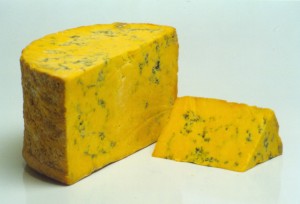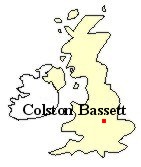 |
|
||||||
Shropshire Blue originated at the Castle Stuart Dairy, Inverness in the 1970's where it was called 'Inverness-shire Blue' or 'Blue Stuart'. It was made by a Scottish cheese-maker called Andy Williamson who was trained in the making of Stilton in Nottinghamshire. He returned to Scotland to produce the first Scottish Blue cheeses which included cheeses similar not only to Stilton but also to Blue Cheshire and Wensleydale. Inverness-shire Blue, or Blue Stuart, was marketed throughout the rest of the British Isles as Shropshire Blue; a name chosen simply to help its sales and acceptability. However, in 1980 production of the cheese stopped as the Milk Marketing Board of Northern Scotland brutally shut down the creamery killing off a number of Scottish cheeses and its only blues. The making of the cheese was however taken up by the Cheshire cheese maker Elliot Hulme and Harry Hanlin along with the help and advice of Charlie Chisholm, who worked at the Castle Stuart Dairy. The first Shropshire Blue from the farm then appeared at the Nantwich show in 1980. However, soon after this they too also stopped making the cheese. Fortunately, the making of the cheese moved to Nottinghamshire when Long Clawson Dairy and Colston Bassett Dairy took up production. An ironic return to the area of Shropshire Blues real birth-place in the early years of the creators life, Andy Williamson. Shropshire Blue has a flavour somewhere between Blue Cheshire and Blue Stilton, a creamy orange coloured paste with blue-green veining; annatto produces the orange colour and Penicillium roquefortii produces the veining. The cheese is essentially an orange coloured Stilton style cheese. It is made from pasteurised cows' milk and using rennet suitable for vegetarians. The cheese is matured for 12 weeks but it can be matured for a further 12 weeks to produce a creamier fuller flavoured cheese. Shropshire Blue is excellent throughout the year. Each cheese is approximately 20cm in diameter, 30cm high, weighs 8kg and has a fat content of 48%. It is excellent on the cheese-board and is also very versatile in the kitchen; it makes fabulous soups and sauces. It is best accompanied by good English brown ale and as with Stilton, by rich fortified wines. Click here or press your 'Back' button to return |
Click here or press your 'Back' button to return
|
||||||
| All articles © www.teddingtoncheese.co.uk | |||||||
